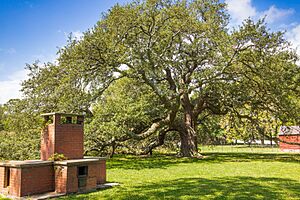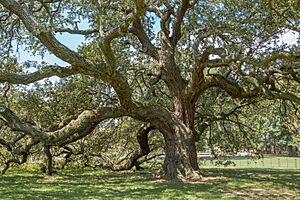Emancipation Oak facts for kids
Quick facts for kids |
|
|
Emancipation Oak
|
|
|
U.S. Historic district
Contributing property |
|
| Lua error in Module:Location_map at line 420: attempt to index field 'wikibase' (a nil value). | |
| Location | Hampton University |
|---|---|
| Part of | Hampton Institute |
| NRHP reference No. | 69000323 |
| Added to NRHP | November 12, 1969 |
The Emancipation Oak is a very old and special tree. It stands on the campus of Hampton University in Hampton, Virginia, in the United States. This huge southern live oak tree is thought to be over 200 years old. Its branches spread out wide, making it about 98 feet (30 meters) across. The Emancipation Oak is a famous part of the National Historic Landmark district of Hampton University. It is known for its important role in American history.
Contents
The Story of the Emancipation Oak
A Safe Place During the Civil War
During the American Civil War, which happened from 1861 to 1865, many African American people escaped from slavery. They found safety at a place called Fort Monroe in Virginia. The United States Army called these people "contraband of war." This was a way to legally offer them protection and a safe place. Before the war, a law in Virginia had made it illegal to teach enslaved people how to read or write. This law was put in place after a rebellion in 1831.
Mary Peake's Outdoor Classroom
In November 1861, a group called the American Missionary Association (AMA) asked a brave teacher named Mary S. Peake to help. They wanted her to teach the children of these newly freed people. Mary Peake started her classes outside, right under the big branches of this very oak tree. She was the first Black teacher hired by the AMA. This group later helped start many schools across the Southern United States.
Mary Peake's teaching spot was about three miles from the safety of Fort Monroe. But her classes were so important that even adults came to learn at night. Soon, the AMA gave her a building called the Brown Cottage for her school. She taught up to 50 children during the day and 20 adults at night.
The Freedom Proclamation
In 1863, something very important happened under the Emancipation Oak. The Black community on the Virginia Peninsula gathered there. They came to hear the first public reading of President Abraham Lincoln's Emancipation Proclamation in the Southern United States. This special order declared that many enslaved people were now free. Because of this historic event, the tree became known as the Emancipation Oak. It became a symbol of freedom.
Building a Future: Hampton Institute
After the Civil War ended, General Samuel C. Armstrong and the American Missionary Association started a school. They founded the Hampton Normal and Agricultural Institute in 1868. This school was built on the same land where the Emancipation Oak stood. From 1872 to 1875, a famous student named Booker T. Washington attended this school. He was the son of a freedman.
Booker T. Washington later became a very important educator. In 1881, he founded the Tuskegee Institute in Alabama. In the early 1900s, he worked with a generous person named Julius Rosenwald. Together, they helped create many rural schools for African-American children across the Southern United States.
Over the years, the school changed its name. In 1930, it became Hampton Institute. Then, in 1984, it became a university, known as Hampton University. Today, it is one of Virginia's main universities. The Emancipation Oak still stands tall, giving shade and inspiration to all the students and staff at Hampton University.
See also
- 140th Year Anniversary Celebration of the Emancipation Proclamation
- Mary Smith Peake
- List of individual trees



